Management Studies: Construction of New Halls of Residence
VerifiedAdded on 2023/01/12
|10
|3604
|34
AI Summary
This report discusses the construction of new halls of residence in the University campus at Docklands. It includes a detailed method statement for main activities, risk identification and solutions, project logic plan, logistics plan, and solid waste management plan.
Contribute Materials
Your contribution can guide someone’s learning journey. Share your
documents today.
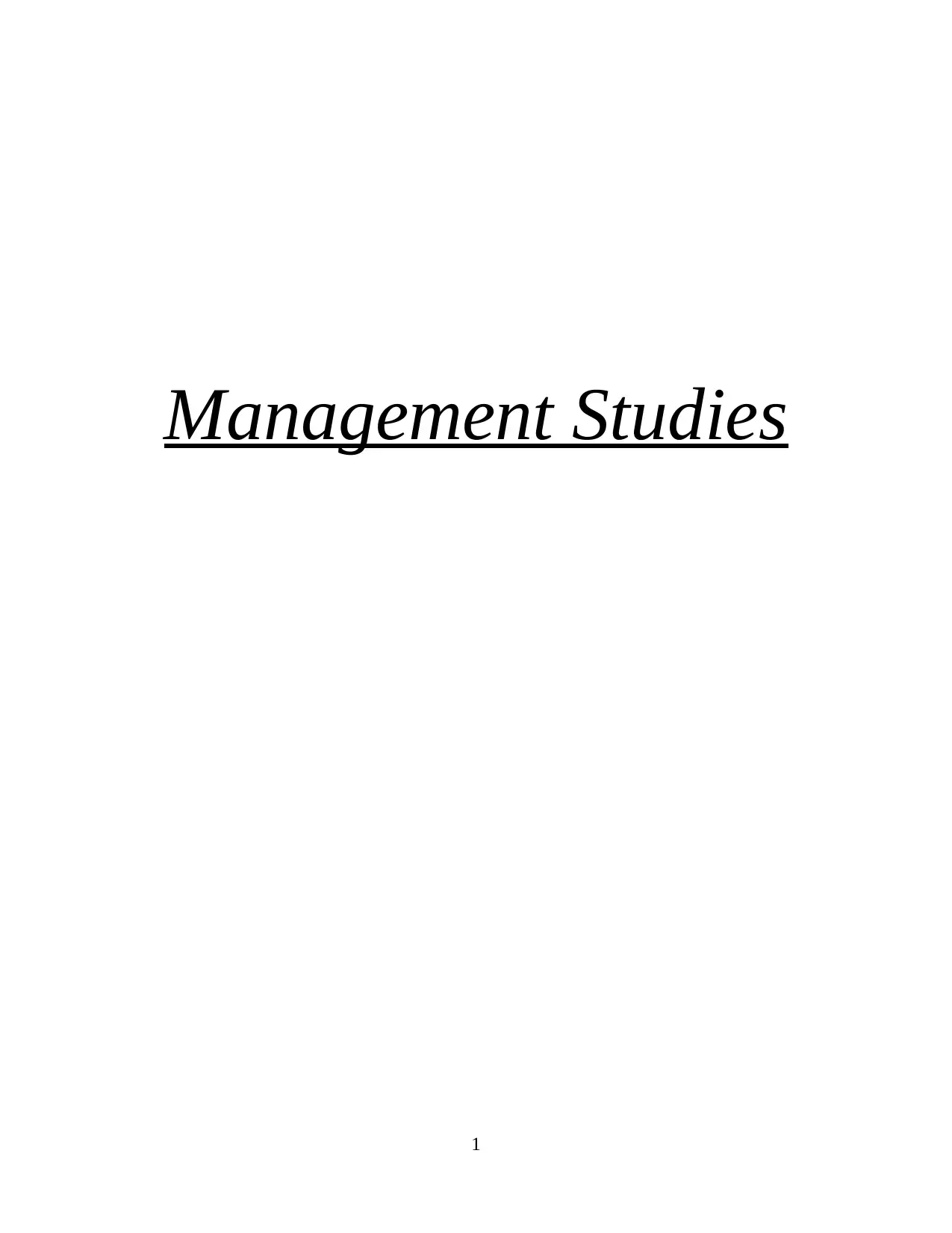
Management Studies
1
1
Secure Best Marks with AI Grader
Need help grading? Try our AI Grader for instant feedback on your assignments.
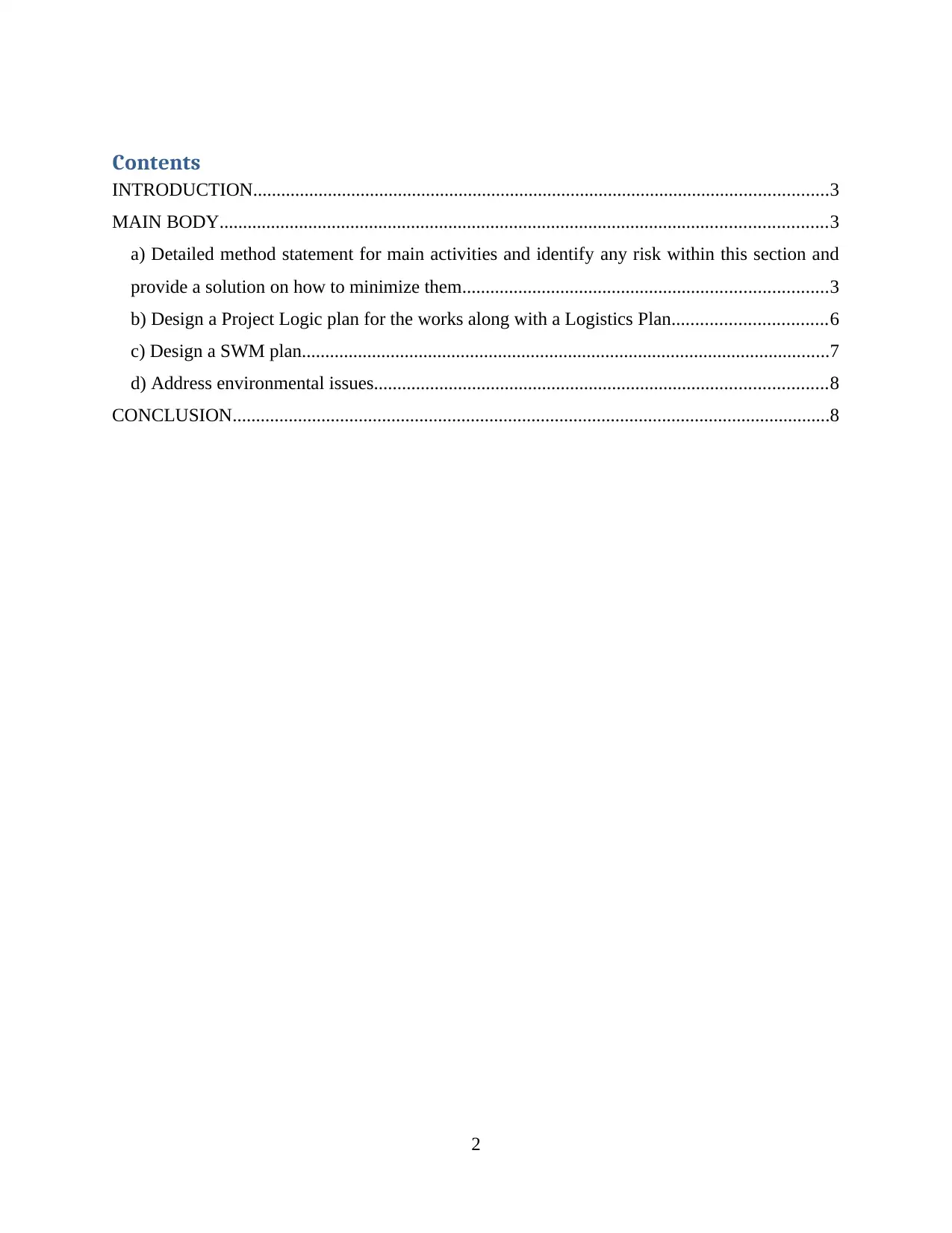
Contents
INTRODUCTION...........................................................................................................................3
MAIN BODY..................................................................................................................................3
a) Detailed method statement for main activities and identify any risk within this section and
provide a solution on how to minimize them..............................................................................3
b) Design a Project Logic plan for the works along with a Logistics Plan.................................6
c) Design a SWM plan.................................................................................................................7
d) Address environmental issues.................................................................................................8
CONCLUSION................................................................................................................................8
2
INTRODUCTION...........................................................................................................................3
MAIN BODY..................................................................................................................................3
a) Detailed method statement for main activities and identify any risk within this section and
provide a solution on how to minimize them..............................................................................3
b) Design a Project Logic plan for the works along with a Logistics Plan.................................6
c) Design a SWM plan.................................................................................................................7
d) Address environmental issues.................................................................................................8
CONCLUSION................................................................................................................................8
2
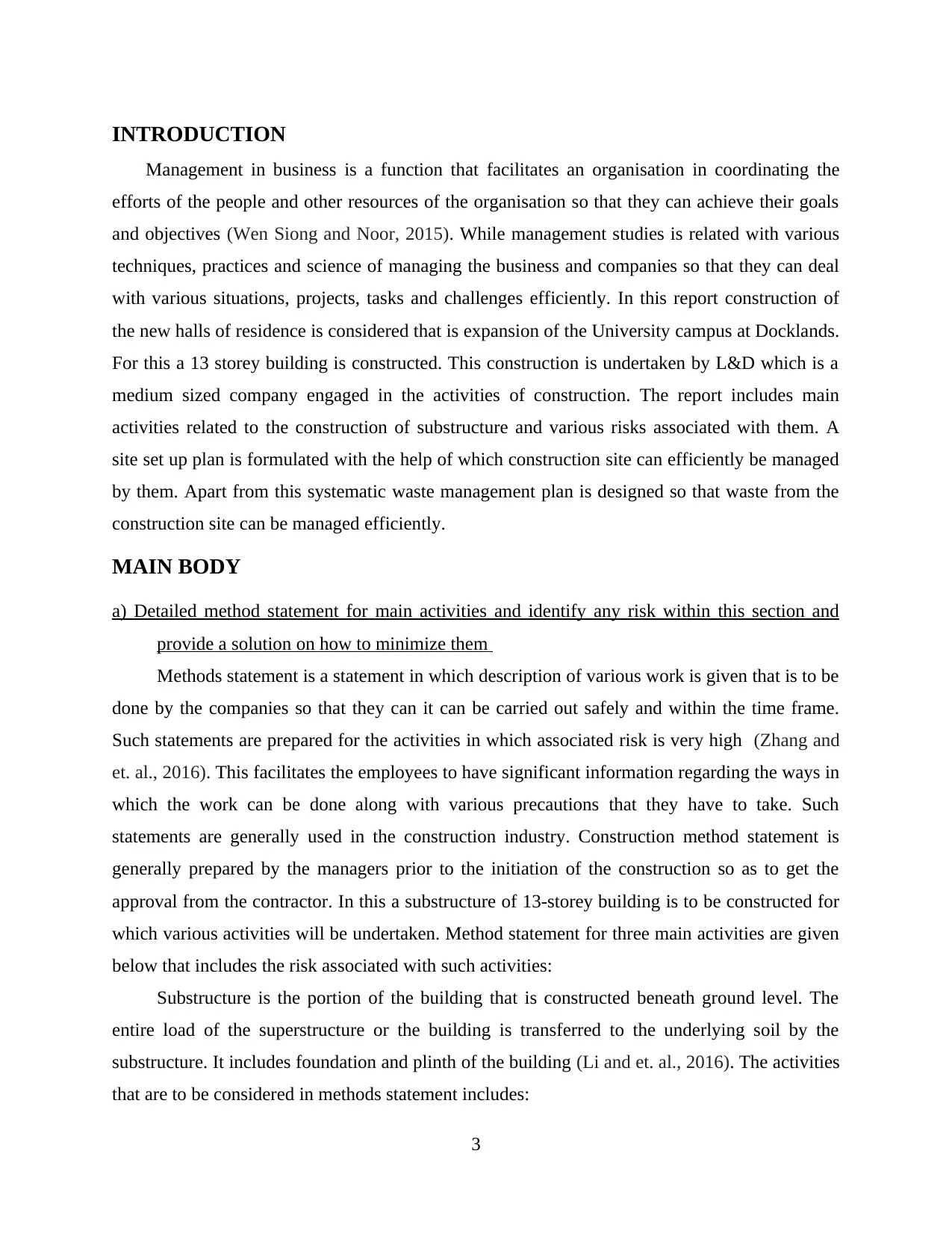
INTRODUCTION
Management in business is a function that facilitates an organisation in coordinating the
efforts of the people and other resources of the organisation so that they can achieve their goals
and objectives (Wen Siong and Noor, 2015). While management studies is related with various
techniques, practices and science of managing the business and companies so that they can deal
with various situations, projects, tasks and challenges efficiently. In this report construction of
the new halls of residence is considered that is expansion of the University campus at Docklands.
For this a 13 storey building is constructed. This construction is undertaken by L&D which is a
medium sized company engaged in the activities of construction. The report includes main
activities related to the construction of substructure and various risks associated with them. A
site set up plan is formulated with the help of which construction site can efficiently be managed
by them. Apart from this systematic waste management plan is designed so that waste from the
construction site can be managed efficiently.
MAIN BODY
a) Detailed method statement for main activities and identify any risk within this section and
provide a solution on how to minimize them
Methods statement is a statement in which description of various work is given that is to be
done by the companies so that they can it can be carried out safely and within the time frame.
Such statements are prepared for the activities in which associated risk is very high (Zhang and
et. al., 2016). This facilitates the employees to have significant information regarding the ways in
which the work can be done along with various precautions that they have to take. Such
statements are generally used in the construction industry. Construction method statement is
generally prepared by the managers prior to the initiation of the construction so as to get the
approval from the contractor. In this a substructure of 13-storey building is to be constructed for
which various activities will be undertaken. Method statement for three main activities are given
below that includes the risk associated with such activities:
Substructure is the portion of the building that is constructed beneath ground level. The
entire load of the superstructure or the building is transferred to the underlying soil by the
substructure. It includes foundation and plinth of the building (Li and et. al., 2016). The activities
that are to be considered in methods statement includes:
3
Management in business is a function that facilitates an organisation in coordinating the
efforts of the people and other resources of the organisation so that they can achieve their goals
and objectives (Wen Siong and Noor, 2015). While management studies is related with various
techniques, practices and science of managing the business and companies so that they can deal
with various situations, projects, tasks and challenges efficiently. In this report construction of
the new halls of residence is considered that is expansion of the University campus at Docklands.
For this a 13 storey building is constructed. This construction is undertaken by L&D which is a
medium sized company engaged in the activities of construction. The report includes main
activities related to the construction of substructure and various risks associated with them. A
site set up plan is formulated with the help of which construction site can efficiently be managed
by them. Apart from this systematic waste management plan is designed so that waste from the
construction site can be managed efficiently.
MAIN BODY
a) Detailed method statement for main activities and identify any risk within this section and
provide a solution on how to minimize them
Methods statement is a statement in which description of various work is given that is to be
done by the companies so that they can it can be carried out safely and within the time frame.
Such statements are prepared for the activities in which associated risk is very high (Zhang and
et. al., 2016). This facilitates the employees to have significant information regarding the ways in
which the work can be done along with various precautions that they have to take. Such
statements are generally used in the construction industry. Construction method statement is
generally prepared by the managers prior to the initiation of the construction so as to get the
approval from the contractor. In this a substructure of 13-storey building is to be constructed for
which various activities will be undertaken. Method statement for three main activities are given
below that includes the risk associated with such activities:
Substructure is the portion of the building that is constructed beneath ground level. The
entire load of the superstructure or the building is transferred to the underlying soil by the
substructure. It includes foundation and plinth of the building (Li and et. al., 2016). The activities
that are to be considered in methods statement includes:
3
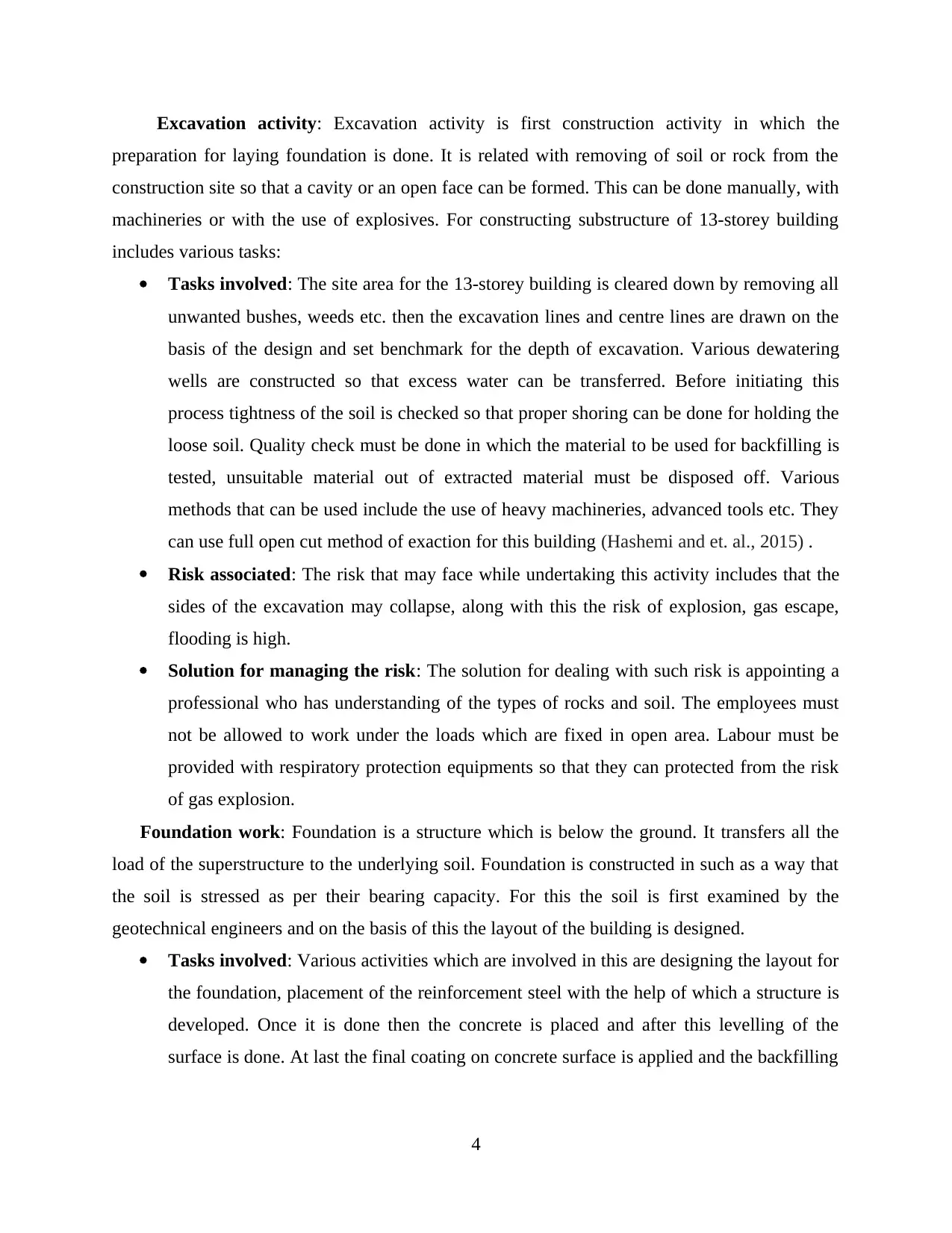
Excavation activity: Excavation activity is first construction activity in which the
preparation for laying foundation is done. It is related with removing of soil or rock from the
construction site so that a cavity or an open face can be formed. This can be done manually, with
machineries or with the use of explosives. For constructing substructure of 13-storey building
includes various tasks:
Tasks involved: The site area for the 13-storey building is cleared down by removing all
unwanted bushes, weeds etc. then the excavation lines and centre lines are drawn on the
basis of the design and set benchmark for the depth of excavation. Various dewatering
wells are constructed so that excess water can be transferred. Before initiating this
process tightness of the soil is checked so that proper shoring can be done for holding the
loose soil. Quality check must be done in which the material to be used for backfilling is
tested, unsuitable material out of extracted material must be disposed off. Various
methods that can be used include the use of heavy machineries, advanced tools etc. They
can use full open cut method of exaction for this building (Hashemi and et. al., 2015) .
Risk associated: The risk that may face while undertaking this activity includes that the
sides of the excavation may collapse, along with this the risk of explosion, gas escape,
flooding is high.
Solution for managing the risk: The solution for dealing with such risk is appointing a
professional who has understanding of the types of rocks and soil. The employees must
not be allowed to work under the loads which are fixed in open area. Labour must be
provided with respiratory protection equipments so that they can protected from the risk
of gas explosion.
Foundation work: Foundation is a structure which is below the ground. It transfers all the
load of the superstructure to the underlying soil. Foundation is constructed in such as a way that
the soil is stressed as per their bearing capacity. For this the soil is first examined by the
geotechnical engineers and on the basis of this the layout of the building is designed.
Tasks involved: Various activities which are involved in this are designing the layout for
the foundation, placement of the reinforcement steel with the help of which a structure is
developed. Once it is done then the concrete is placed and after this levelling of the
surface is done. At last the final coating on concrete surface is applied and the backfilling
4
preparation for laying foundation is done. It is related with removing of soil or rock from the
construction site so that a cavity or an open face can be formed. This can be done manually, with
machineries or with the use of explosives. For constructing substructure of 13-storey building
includes various tasks:
Tasks involved: The site area for the 13-storey building is cleared down by removing all
unwanted bushes, weeds etc. then the excavation lines and centre lines are drawn on the
basis of the design and set benchmark for the depth of excavation. Various dewatering
wells are constructed so that excess water can be transferred. Before initiating this
process tightness of the soil is checked so that proper shoring can be done for holding the
loose soil. Quality check must be done in which the material to be used for backfilling is
tested, unsuitable material out of extracted material must be disposed off. Various
methods that can be used include the use of heavy machineries, advanced tools etc. They
can use full open cut method of exaction for this building (Hashemi and et. al., 2015) .
Risk associated: The risk that may face while undertaking this activity includes that the
sides of the excavation may collapse, along with this the risk of explosion, gas escape,
flooding is high.
Solution for managing the risk: The solution for dealing with such risk is appointing a
professional who has understanding of the types of rocks and soil. The employees must
not be allowed to work under the loads which are fixed in open area. Labour must be
provided with respiratory protection equipments so that they can protected from the risk
of gas explosion.
Foundation work: Foundation is a structure which is below the ground. It transfers all the
load of the superstructure to the underlying soil. Foundation is constructed in such as a way that
the soil is stressed as per their bearing capacity. For this the soil is first examined by the
geotechnical engineers and on the basis of this the layout of the building is designed.
Tasks involved: Various activities which are involved in this are designing the layout for
the foundation, placement of the reinforcement steel with the help of which a structure is
developed. Once it is done then the concrete is placed and after this levelling of the
surface is done. At last the final coating on concrete surface is applied and the backfilling
4
Secure Best Marks with AI Grader
Need help grading? Try our AI Grader for instant feedback on your assignments.
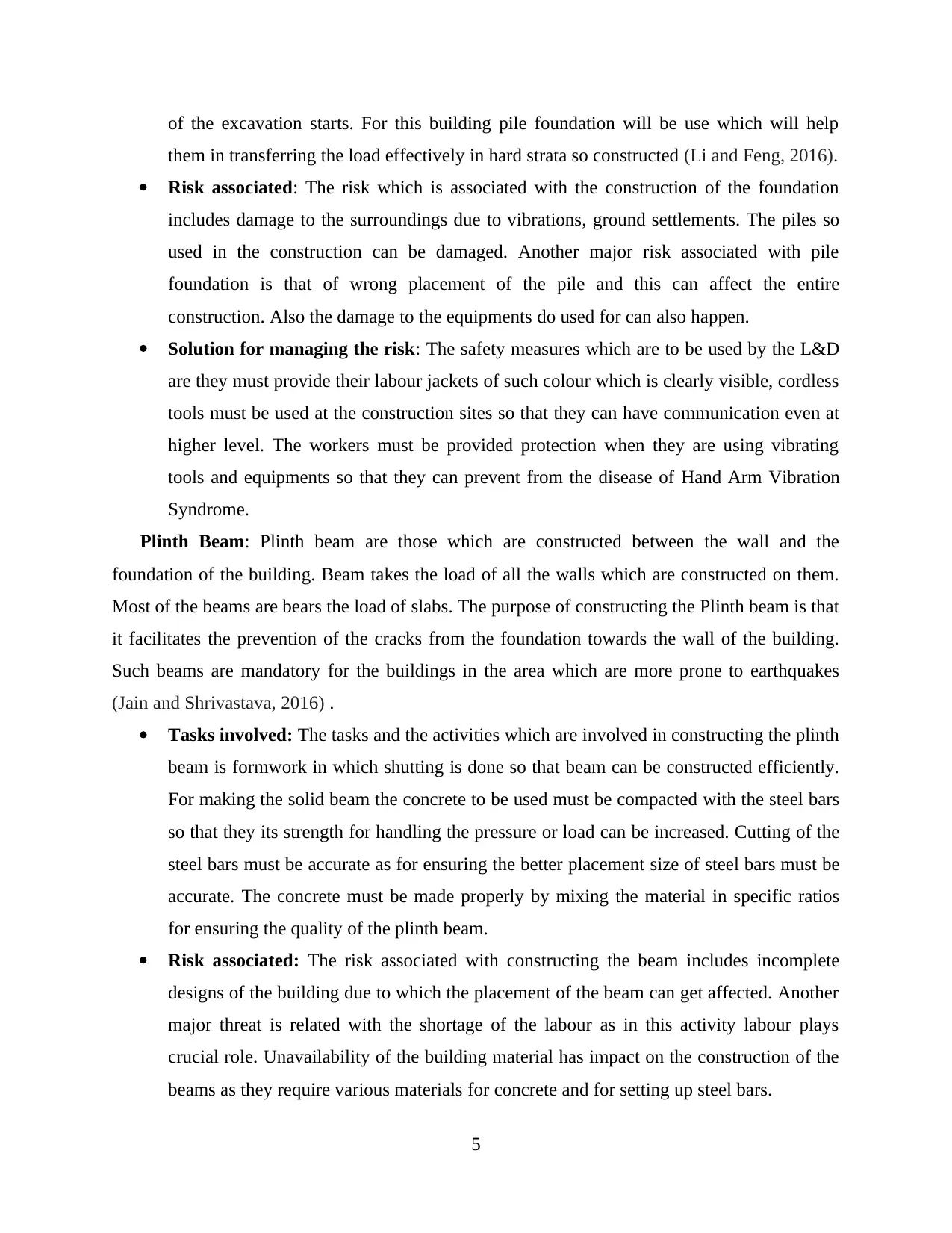
of the excavation starts. For this building pile foundation will be use which will help
them in transferring the load effectively in hard strata so constructed (Li and Feng, 2016).
Risk associated: The risk which is associated with the construction of the foundation
includes damage to the surroundings due to vibrations, ground settlements. The piles so
used in the construction can be damaged. Another major risk associated with pile
foundation is that of wrong placement of the pile and this can affect the entire
construction. Also the damage to the equipments do used for can also happen.
Solution for managing the risk: The safety measures which are to be used by the L&D
are they must provide their labour jackets of such colour which is clearly visible, cordless
tools must be used at the construction sites so that they can have communication even at
higher level. The workers must be provided protection when they are using vibrating
tools and equipments so that they can prevent from the disease of Hand Arm Vibration
Syndrome.
Plinth Beam: Plinth beam are those which are constructed between the wall and the
foundation of the building. Beam takes the load of all the walls which are constructed on them.
Most of the beams are bears the load of slabs. The purpose of constructing the Plinth beam is that
it facilitates the prevention of the cracks from the foundation towards the wall of the building.
Such beams are mandatory for the buildings in the area which are more prone to earthquakes
(Jain and Shrivastava, 2016) .
Tasks involved: The tasks and the activities which are involved in constructing the plinth
beam is formwork in which shutting is done so that beam can be constructed efficiently.
For making the solid beam the concrete to be used must be compacted with the steel bars
so that they its strength for handling the pressure or load can be increased. Cutting of the
steel bars must be accurate as for ensuring the better placement size of steel bars must be
accurate. The concrete must be made properly by mixing the material in specific ratios
for ensuring the quality of the plinth beam.
Risk associated: The risk associated with constructing the beam includes incomplete
designs of the building due to which the placement of the beam can get affected. Another
major threat is related with the shortage of the labour as in this activity labour plays
crucial role. Unavailability of the building material has impact on the construction of the
beams as they require various materials for concrete and for setting up steel bars.
5
them in transferring the load effectively in hard strata so constructed (Li and Feng, 2016).
Risk associated: The risk which is associated with the construction of the foundation
includes damage to the surroundings due to vibrations, ground settlements. The piles so
used in the construction can be damaged. Another major risk associated with pile
foundation is that of wrong placement of the pile and this can affect the entire
construction. Also the damage to the equipments do used for can also happen.
Solution for managing the risk: The safety measures which are to be used by the L&D
are they must provide their labour jackets of such colour which is clearly visible, cordless
tools must be used at the construction sites so that they can have communication even at
higher level. The workers must be provided protection when they are using vibrating
tools and equipments so that they can prevent from the disease of Hand Arm Vibration
Syndrome.
Plinth Beam: Plinth beam are those which are constructed between the wall and the
foundation of the building. Beam takes the load of all the walls which are constructed on them.
Most of the beams are bears the load of slabs. The purpose of constructing the Plinth beam is that
it facilitates the prevention of the cracks from the foundation towards the wall of the building.
Such beams are mandatory for the buildings in the area which are more prone to earthquakes
(Jain and Shrivastava, 2016) .
Tasks involved: The tasks and the activities which are involved in constructing the plinth
beam is formwork in which shutting is done so that beam can be constructed efficiently.
For making the solid beam the concrete to be used must be compacted with the steel bars
so that they its strength for handling the pressure or load can be increased. Cutting of the
steel bars must be accurate as for ensuring the better placement size of steel bars must be
accurate. The concrete must be made properly by mixing the material in specific ratios
for ensuring the quality of the plinth beam.
Risk associated: The risk associated with constructing the beam includes incomplete
designs of the building due to which the placement of the beam can get affected. Another
major threat is related with the shortage of the labour as in this activity labour plays
crucial role. Unavailability of the building material has impact on the construction of the
beams as they require various materials for concrete and for setting up steel bars.
5
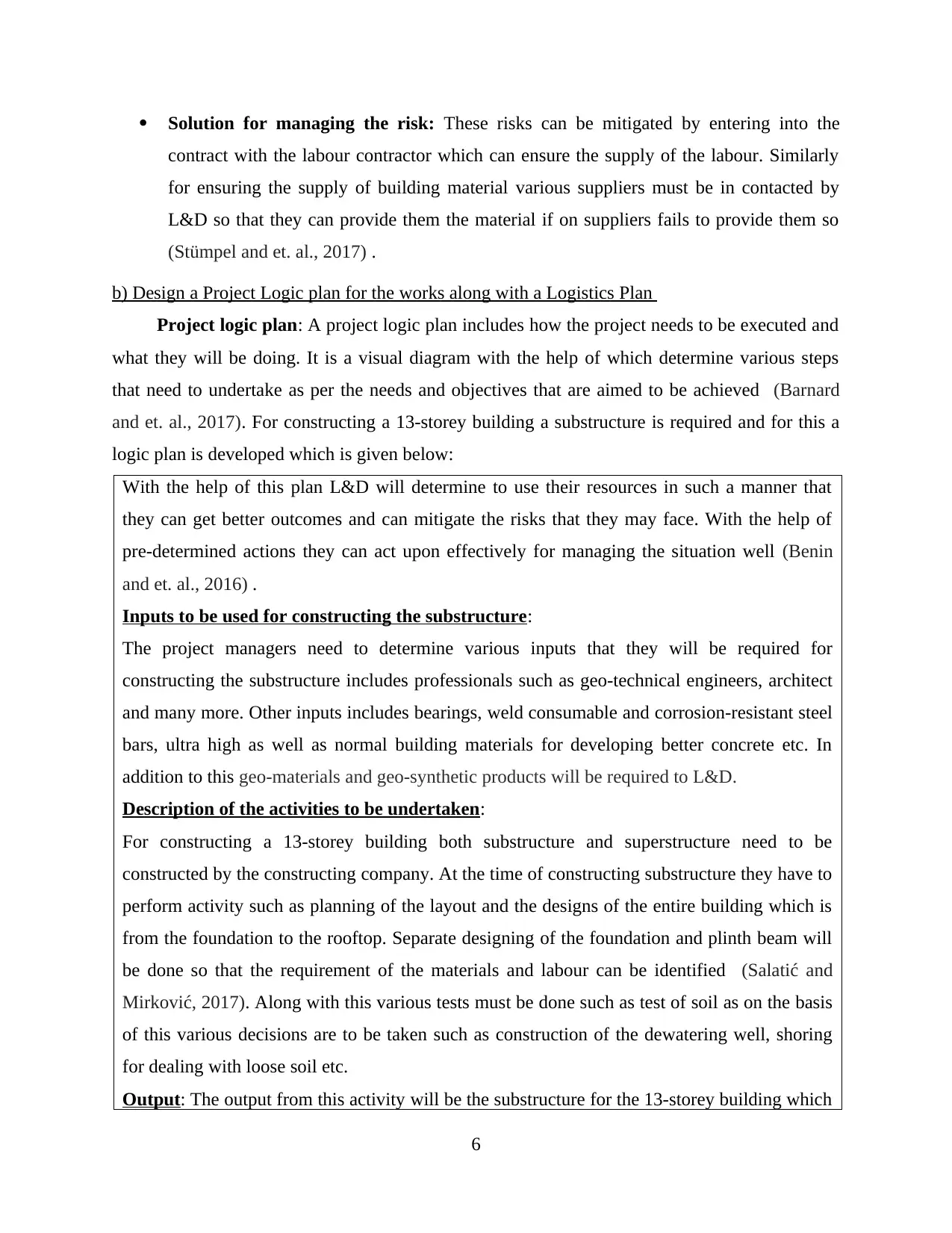
Solution for managing the risk: These risks can be mitigated by entering into the
contract with the labour contractor which can ensure the supply of the labour. Similarly
for ensuring the supply of building material various suppliers must be in contacted by
L&D so that they can provide them the material if on suppliers fails to provide them so
(Stümpel and et. al., 2017) .
b) Design a Project Logic plan for the works along with a Logistics Plan
Project logic plan: A project logic plan includes how the project needs to be executed and
what they will be doing. It is a visual diagram with the help of which determine various steps
that need to undertake as per the needs and objectives that are aimed to be achieved (Barnard
and et. al., 2017). For constructing a 13-storey building a substructure is required and for this a
logic plan is developed which is given below:
With the help of this plan L&D will determine to use their resources in such a manner that
they can get better outcomes and can mitigate the risks that they may face. With the help of
pre-determined actions they can act upon effectively for managing the situation well (Benin
and et. al., 2016) .
Inputs to be used for constructing the substructure:
The project managers need to determine various inputs that they will be required for
constructing the substructure includes professionals such as geo-technical engineers, architect
and many more. Other inputs includes bearings, weld consumable and corrosion-resistant steel
bars, ultra high as well as normal building materials for developing better concrete etc. In
addition to this geo-materials and geo-synthetic products will be required to L&D.
Description of the activities to be undertaken:
For constructing a 13-storey building both substructure and superstructure need to be
constructed by the constructing company. At the time of constructing substructure they have to
perform activity such as planning of the layout and the designs of the entire building which is
from the foundation to the rooftop. Separate designing of the foundation and plinth beam will
be done so that the requirement of the materials and labour can be identified (Salatić and
Mirković, 2017). Along with this various tests must be done such as test of soil as on the basis
of this various decisions are to be taken such as construction of the dewatering well, shoring
for dealing with loose soil etc.
Output: The output from this activity will be the substructure for the 13-storey building which
6
contract with the labour contractor which can ensure the supply of the labour. Similarly
for ensuring the supply of building material various suppliers must be in contacted by
L&D so that they can provide them the material if on suppliers fails to provide them so
(Stümpel and et. al., 2017) .
b) Design a Project Logic plan for the works along with a Logistics Plan
Project logic plan: A project logic plan includes how the project needs to be executed and
what they will be doing. It is a visual diagram with the help of which determine various steps
that need to undertake as per the needs and objectives that are aimed to be achieved (Barnard
and et. al., 2017). For constructing a 13-storey building a substructure is required and for this a
logic plan is developed which is given below:
With the help of this plan L&D will determine to use their resources in such a manner that
they can get better outcomes and can mitigate the risks that they may face. With the help of
pre-determined actions they can act upon effectively for managing the situation well (Benin
and et. al., 2016) .
Inputs to be used for constructing the substructure:
The project managers need to determine various inputs that they will be required for
constructing the substructure includes professionals such as geo-technical engineers, architect
and many more. Other inputs includes bearings, weld consumable and corrosion-resistant steel
bars, ultra high as well as normal building materials for developing better concrete etc. In
addition to this geo-materials and geo-synthetic products will be required to L&D.
Description of the activities to be undertaken:
For constructing a 13-storey building both substructure and superstructure need to be
constructed by the constructing company. At the time of constructing substructure they have to
perform activity such as planning of the layout and the designs of the entire building which is
from the foundation to the rooftop. Separate designing of the foundation and plinth beam will
be done so that the requirement of the materials and labour can be identified (Salatić and
Mirković, 2017). Along with this various tests must be done such as test of soil as on the basis
of this various decisions are to be taken such as construction of the dewatering well, shoring
for dealing with loose soil etc.
Output: The output from this activity will be the substructure for the 13-storey building which
6
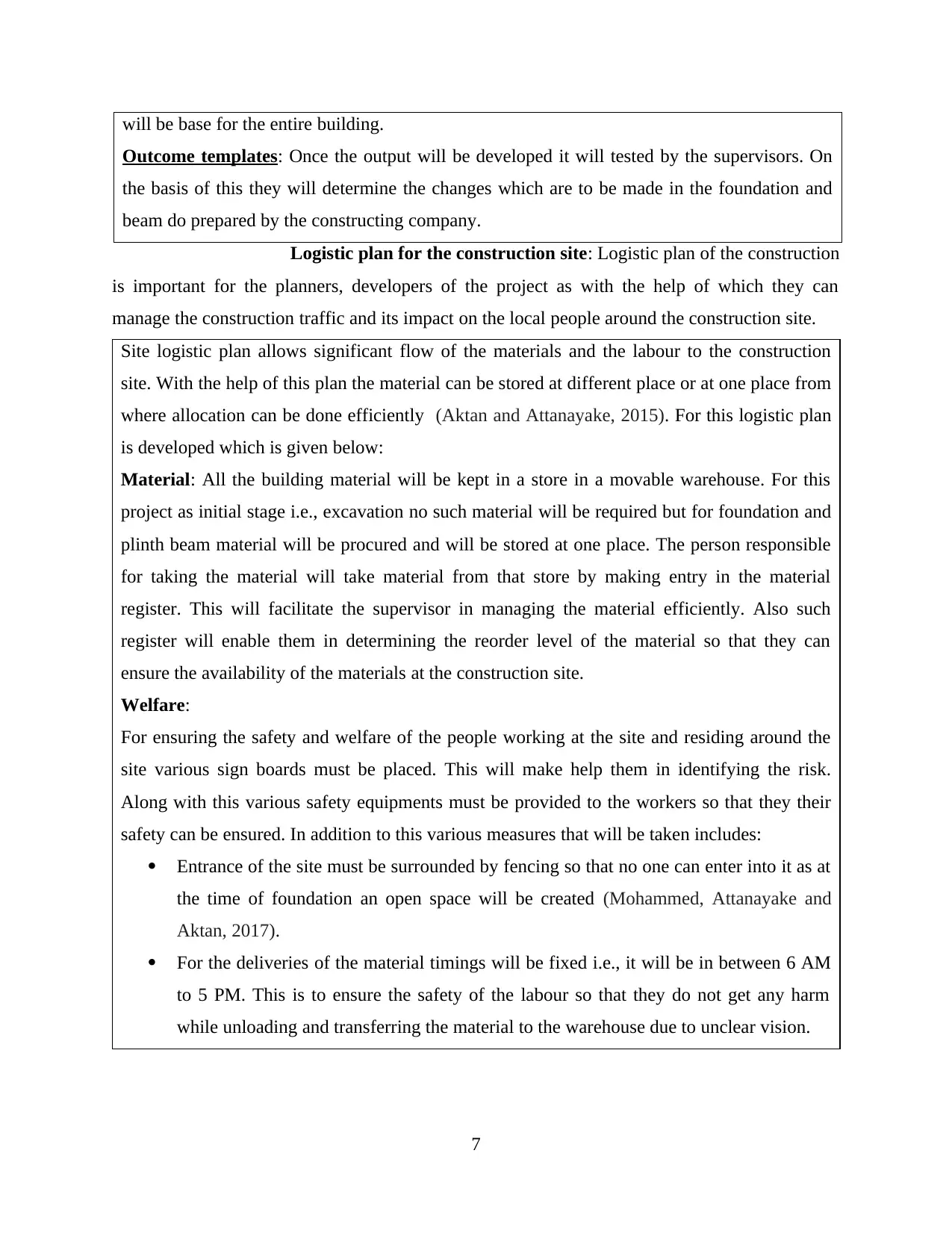
will be base for the entire building.
Outcome templates: Once the output will be developed it will tested by the supervisors. On
the basis of this they will determine the changes which are to be made in the foundation and
beam do prepared by the constructing company.
Logistic plan for the construction site: Logistic plan of the construction
is important for the planners, developers of the project as with the help of which they can
manage the construction traffic and its impact on the local people around the construction site.
Site logistic plan allows significant flow of the materials and the labour to the construction
site. With the help of this plan the material can be stored at different place or at one place from
where allocation can be done efficiently (Aktan and Attanayake, 2015). For this logistic plan
is developed which is given below:
Material: All the building material will be kept in a store in a movable warehouse. For this
project as initial stage i.e., excavation no such material will be required but for foundation and
plinth beam material will be procured and will be stored at one place. The person responsible
for taking the material will take material from that store by making entry in the material
register. This will facilitate the supervisor in managing the material efficiently. Also such
register will enable them in determining the reorder level of the material so that they can
ensure the availability of the materials at the construction site.
Welfare:
For ensuring the safety and welfare of the people working at the site and residing around the
site various sign boards must be placed. This will make help them in identifying the risk.
Along with this various safety equipments must be provided to the workers so that they their
safety can be ensured. In addition to this various measures that will be taken includes:
Entrance of the site must be surrounded by fencing so that no one can enter into it as at
the time of foundation an open space will be created (Mohammed, Attanayake and
Aktan, 2017).
For the deliveries of the material timings will be fixed i.e., it will be in between 6 AM
to 5 PM. This is to ensure the safety of the labour so that they do not get any harm
while unloading and transferring the material to the warehouse due to unclear vision.
7
Outcome templates: Once the output will be developed it will tested by the supervisors. On
the basis of this they will determine the changes which are to be made in the foundation and
beam do prepared by the constructing company.
Logistic plan for the construction site: Logistic plan of the construction
is important for the planners, developers of the project as with the help of which they can
manage the construction traffic and its impact on the local people around the construction site.
Site logistic plan allows significant flow of the materials and the labour to the construction
site. With the help of this plan the material can be stored at different place or at one place from
where allocation can be done efficiently (Aktan and Attanayake, 2015). For this logistic plan
is developed which is given below:
Material: All the building material will be kept in a store in a movable warehouse. For this
project as initial stage i.e., excavation no such material will be required but for foundation and
plinth beam material will be procured and will be stored at one place. The person responsible
for taking the material will take material from that store by making entry in the material
register. This will facilitate the supervisor in managing the material efficiently. Also such
register will enable them in determining the reorder level of the material so that they can
ensure the availability of the materials at the construction site.
Welfare:
For ensuring the safety and welfare of the people working at the site and residing around the
site various sign boards must be placed. This will make help them in identifying the risk.
Along with this various safety equipments must be provided to the workers so that they their
safety can be ensured. In addition to this various measures that will be taken includes:
Entrance of the site must be surrounded by fencing so that no one can enter into it as at
the time of foundation an open space will be created (Mohammed, Attanayake and
Aktan, 2017).
For the deliveries of the material timings will be fixed i.e., it will be in between 6 AM
to 5 PM. This is to ensure the safety of the labour so that they do not get any harm
while unloading and transferring the material to the warehouse due to unclear vision.
7
Paraphrase This Document
Need a fresh take? Get an instant paraphrase of this document with our AI Paraphraser
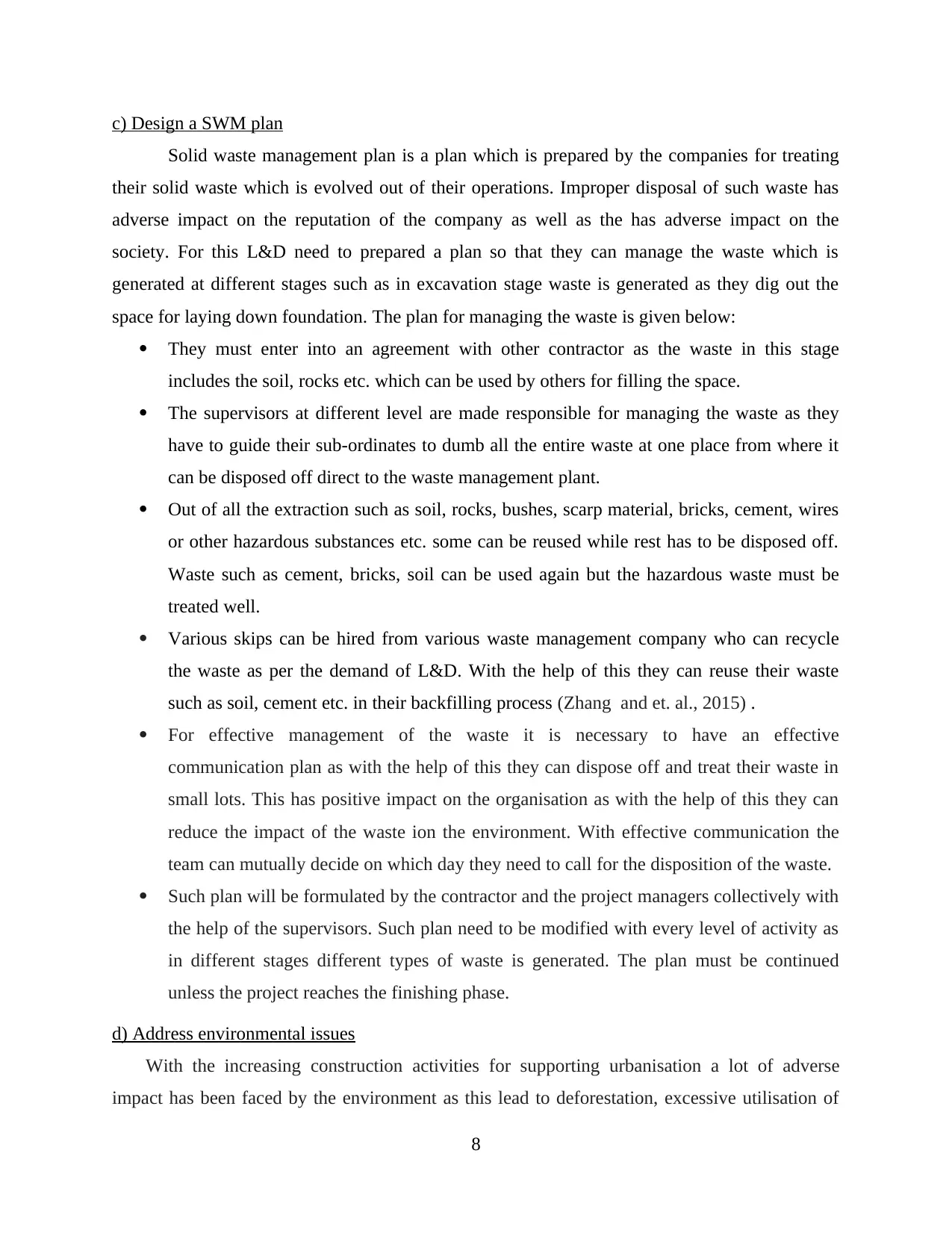
c) Design a SWM plan
Solid waste management plan is a plan which is prepared by the companies for treating
their solid waste which is evolved out of their operations. Improper disposal of such waste has
adverse impact on the reputation of the company as well as the has adverse impact on the
society. For this L&D need to prepared a plan so that they can manage the waste which is
generated at different stages such as in excavation stage waste is generated as they dig out the
space for laying down foundation. The plan for managing the waste is given below:
They must enter into an agreement with other contractor as the waste in this stage
includes the soil, rocks etc. which can be used by others for filling the space.
The supervisors at different level are made responsible for managing the waste as they
have to guide their sub-ordinates to dumb all the entire waste at one place from where it
can be disposed off direct to the waste management plant.
Out of all the extraction such as soil, rocks, bushes, scarp material, bricks, cement, wires
or other hazardous substances etc. some can be reused while rest has to be disposed off.
Waste such as cement, bricks, soil can be used again but the hazardous waste must be
treated well.
Various skips can be hired from various waste management company who can recycle
the waste as per the demand of L&D. With the help of this they can reuse their waste
such as soil, cement etc. in their backfilling process (Zhang and et. al., 2015) .
For effective management of the waste it is necessary to have an effective
communication plan as with the help of this they can dispose off and treat their waste in
small lots. This has positive impact on the organisation as with the help of this they can
reduce the impact of the waste ion the environment. With effective communication the
team can mutually decide on which day they need to call for the disposition of the waste.
Such plan will be formulated by the contractor and the project managers collectively with
the help of the supervisors. Such plan need to be modified with every level of activity as
in different stages different types of waste is generated. The plan must be continued
unless the project reaches the finishing phase.
d) Address environmental issues
With the increasing construction activities for supporting urbanisation a lot of adverse
impact has been faced by the environment as this lead to deforestation, excessive utilisation of
8
Solid waste management plan is a plan which is prepared by the companies for treating
their solid waste which is evolved out of their operations. Improper disposal of such waste has
adverse impact on the reputation of the company as well as the has adverse impact on the
society. For this L&D need to prepared a plan so that they can manage the waste which is
generated at different stages such as in excavation stage waste is generated as they dig out the
space for laying down foundation. The plan for managing the waste is given below:
They must enter into an agreement with other contractor as the waste in this stage
includes the soil, rocks etc. which can be used by others for filling the space.
The supervisors at different level are made responsible for managing the waste as they
have to guide their sub-ordinates to dumb all the entire waste at one place from where it
can be disposed off direct to the waste management plant.
Out of all the extraction such as soil, rocks, bushes, scarp material, bricks, cement, wires
or other hazardous substances etc. some can be reused while rest has to be disposed off.
Waste such as cement, bricks, soil can be used again but the hazardous waste must be
treated well.
Various skips can be hired from various waste management company who can recycle
the waste as per the demand of L&D. With the help of this they can reuse their waste
such as soil, cement etc. in their backfilling process (Zhang and et. al., 2015) .
For effective management of the waste it is necessary to have an effective
communication plan as with the help of this they can dispose off and treat their waste in
small lots. This has positive impact on the organisation as with the help of this they can
reduce the impact of the waste ion the environment. With effective communication the
team can mutually decide on which day they need to call for the disposition of the waste.
Such plan will be formulated by the contractor and the project managers collectively with
the help of the supervisors. Such plan need to be modified with every level of activity as
in different stages different types of waste is generated. The plan must be continued
unless the project reaches the finishing phase.
d) Address environmental issues
With the increasing construction activities for supporting urbanisation a lot of adverse
impact has been faced by the environment as this lead to deforestation, excessive utilisation of
8
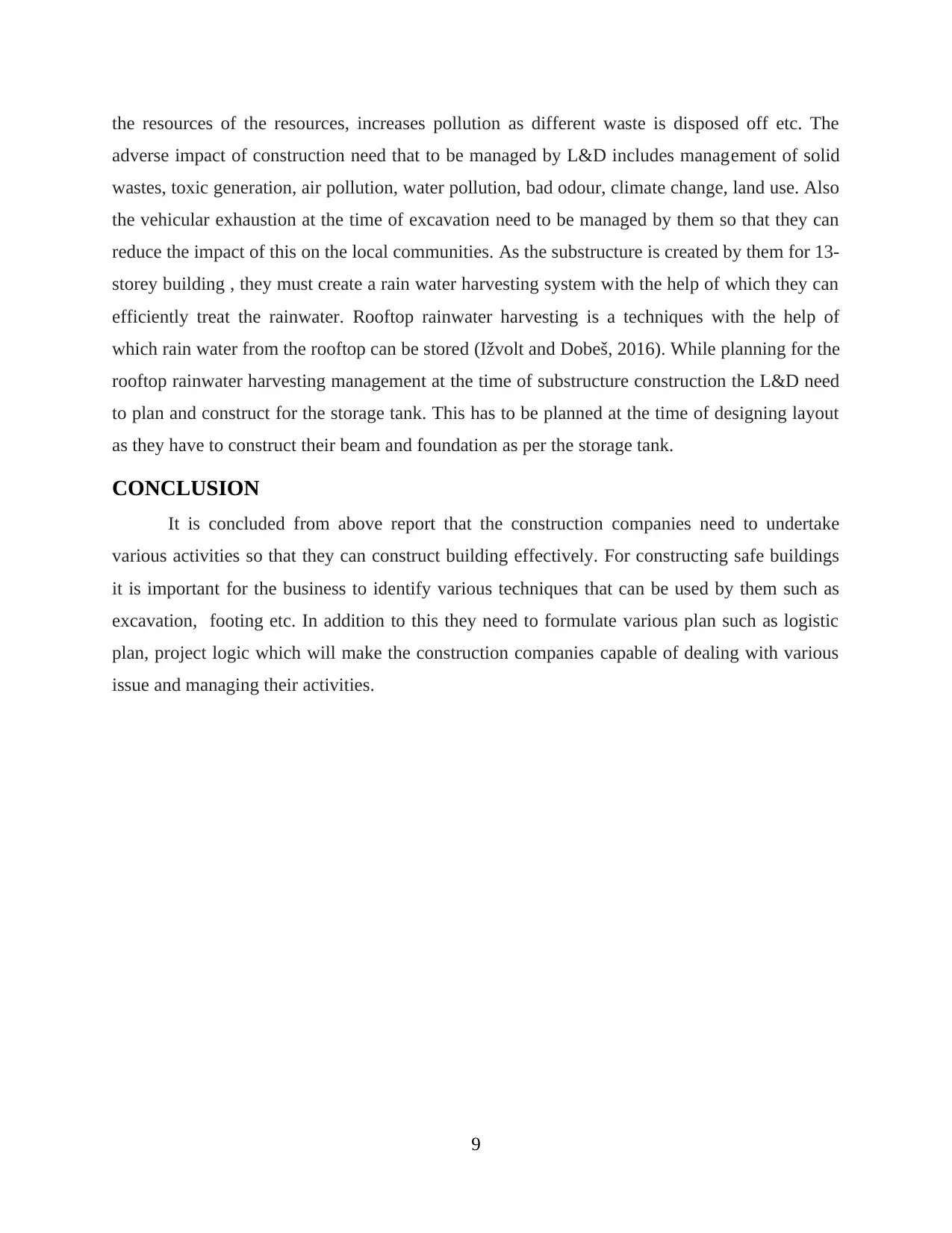
the resources of the resources, increases pollution as different waste is disposed off etc. The
adverse impact of construction need that to be managed by L&D includes management of solid
wastes, toxic generation, air pollution, water pollution, bad odour, climate change, land use. Also
the vehicular exhaustion at the time of excavation need to be managed by them so that they can
reduce the impact of this on the local communities. As the substructure is created by them for 13-
storey building , they must create a rain water harvesting system with the help of which they can
efficiently treat the rainwater. Rooftop rainwater harvesting is a techniques with the help of
which rain water from the rooftop can be stored (Ižvolt and Dobeš, 2016). While planning for the
rooftop rainwater harvesting management at the time of substructure construction the L&D need
to plan and construct for the storage tank. This has to be planned at the time of designing layout
as they have to construct their beam and foundation as per the storage tank.
CONCLUSION
It is concluded from above report that the construction companies need to undertake
various activities so that they can construct building effectively. For constructing safe buildings
it is important for the business to identify various techniques that can be used by them such as
excavation, footing etc. In addition to this they need to formulate various plan such as logistic
plan, project logic which will make the construction companies capable of dealing with various
issue and managing their activities.
9
adverse impact of construction need that to be managed by L&D includes management of solid
wastes, toxic generation, air pollution, water pollution, bad odour, climate change, land use. Also
the vehicular exhaustion at the time of excavation need to be managed by them so that they can
reduce the impact of this on the local communities. As the substructure is created by them for 13-
storey building , they must create a rain water harvesting system with the help of which they can
efficiently treat the rainwater. Rooftop rainwater harvesting is a techniques with the help of
which rain water from the rooftop can be stored (Ižvolt and Dobeš, 2016). While planning for the
rooftop rainwater harvesting management at the time of substructure construction the L&D need
to plan and construct for the storage tank. This has to be planned at the time of designing layout
as they have to construct their beam and foundation as per the storage tank.
CONCLUSION
It is concluded from above report that the construction companies need to undertake
various activities so that they can construct building effectively. For constructing safe buildings
it is important for the business to identify various techniques that can be used by them such as
excavation, footing etc. In addition to this they need to formulate various plan such as logistic
plan, project logic which will make the construction companies capable of dealing with various
issue and managing their activities.
9
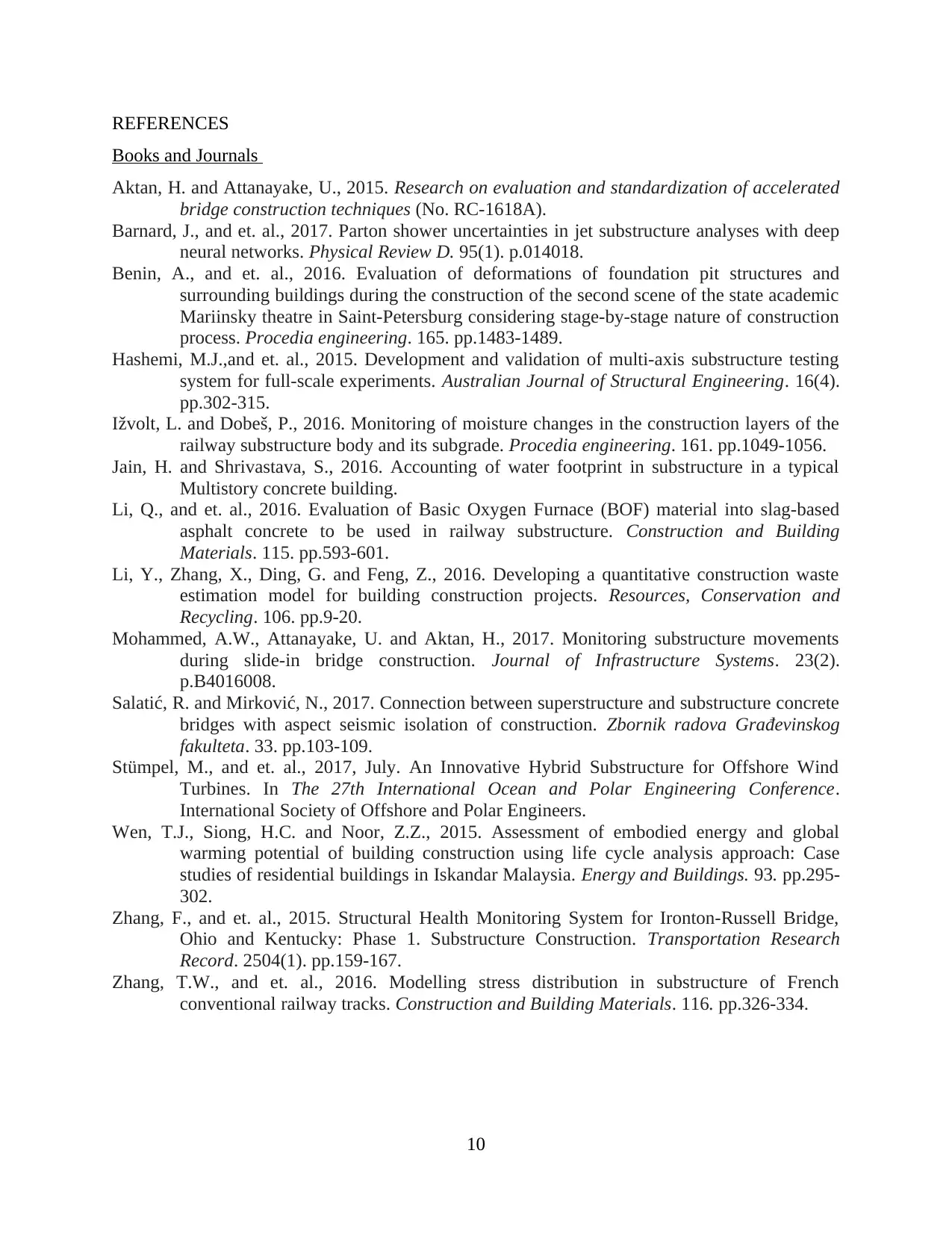
REFERENCES
Books and Journals
Aktan, H. and Attanayake, U., 2015. Research on evaluation and standardization of accelerated
bridge construction techniques (No. RC-1618A).
Barnard, J., and et. al., 2017. Parton shower uncertainties in jet substructure analyses with deep
neural networks. Physical Review D. 95(1). p.014018.
Benin, A., and et. al., 2016. Evaluation of deformations of foundation pit structures and
surrounding buildings during the construction of the second scene of the state academic
Mariinsky theatre in Saint-Petersburg considering stage-by-stage nature of construction
process. Procedia engineering. 165. pp.1483-1489.
Hashemi, M.J.,and et. al., 2015. Development and validation of multi-axis substructure testing
system for full-scale experiments. Australian Journal of Structural Engineering. 16(4).
pp.302-315.
Ižvolt, L. and Dobeš, P., 2016. Monitoring of moisture changes in the construction layers of the
railway substructure body and its subgrade. Procedia engineering. 161. pp.1049-1056.
Jain, H. and Shrivastava, S., 2016. Accounting of water footprint in substructure in a typical
Multistory concrete building.
Li, Q., and et. al., 2016. Evaluation of Basic Oxygen Furnace (BOF) material into slag-based
asphalt concrete to be used in railway substructure. Construction and Building
Materials. 115. pp.593-601.
Li, Y., Zhang, X., Ding, G. and Feng, Z., 2016. Developing a quantitative construction waste
estimation model for building construction projects. Resources, Conservation and
Recycling. 106. pp.9-20.
Mohammed, A.W., Attanayake, U. and Aktan, H., 2017. Monitoring substructure movements
during slide-in bridge construction. Journal of Infrastructure Systems. 23(2).
p.B4016008.
Salatić, R. and Mirković, N., 2017. Connection between superstructure and substructure concrete
bridges with aspect seismic isolation of construction. Zbornik radova Građevinskog
fakulteta. 33. pp.103-109.
Stümpel, M., and et. al., 2017, July. An Innovative Hybrid Substructure for Offshore Wind
Turbines. In The 27th International Ocean and Polar Engineering Conference.
International Society of Offshore and Polar Engineers.
Wen, T.J., Siong, H.C. and Noor, Z.Z., 2015. Assessment of embodied energy and global
warming potential of building construction using life cycle analysis approach: Case
studies of residential buildings in Iskandar Malaysia. Energy and Buildings. 93. pp.295-
302.
Zhang, F., and et. al., 2015. Structural Health Monitoring System for Ironton-Russell Bridge,
Ohio and Kentucky: Phase 1. Substructure Construction. Transportation Research
Record. 2504(1). pp.159-167.
Zhang, T.W., and et. al., 2016. Modelling stress distribution in substructure of French
conventional railway tracks. Construction and Building Materials. 116. pp.326-334.
10
Books and Journals
Aktan, H. and Attanayake, U., 2015. Research on evaluation and standardization of accelerated
bridge construction techniques (No. RC-1618A).
Barnard, J., and et. al., 2017. Parton shower uncertainties in jet substructure analyses with deep
neural networks. Physical Review D. 95(1). p.014018.
Benin, A., and et. al., 2016. Evaluation of deformations of foundation pit structures and
surrounding buildings during the construction of the second scene of the state academic
Mariinsky theatre in Saint-Petersburg considering stage-by-stage nature of construction
process. Procedia engineering. 165. pp.1483-1489.
Hashemi, M.J.,and et. al., 2015. Development and validation of multi-axis substructure testing
system for full-scale experiments. Australian Journal of Structural Engineering. 16(4).
pp.302-315.
Ižvolt, L. and Dobeš, P., 2016. Monitoring of moisture changes in the construction layers of the
railway substructure body and its subgrade. Procedia engineering. 161. pp.1049-1056.
Jain, H. and Shrivastava, S., 2016. Accounting of water footprint in substructure in a typical
Multistory concrete building.
Li, Q., and et. al., 2016. Evaluation of Basic Oxygen Furnace (BOF) material into slag-based
asphalt concrete to be used in railway substructure. Construction and Building
Materials. 115. pp.593-601.
Li, Y., Zhang, X., Ding, G. and Feng, Z., 2016. Developing a quantitative construction waste
estimation model for building construction projects. Resources, Conservation and
Recycling. 106. pp.9-20.
Mohammed, A.W., Attanayake, U. and Aktan, H., 2017. Monitoring substructure movements
during slide-in bridge construction. Journal of Infrastructure Systems. 23(2).
p.B4016008.
Salatić, R. and Mirković, N., 2017. Connection between superstructure and substructure concrete
bridges with aspect seismic isolation of construction. Zbornik radova Građevinskog
fakulteta. 33. pp.103-109.
Stümpel, M., and et. al., 2017, July. An Innovative Hybrid Substructure for Offshore Wind
Turbines. In The 27th International Ocean and Polar Engineering Conference.
International Society of Offshore and Polar Engineers.
Wen, T.J., Siong, H.C. and Noor, Z.Z., 2015. Assessment of embodied energy and global
warming potential of building construction using life cycle analysis approach: Case
studies of residential buildings in Iskandar Malaysia. Energy and Buildings. 93. pp.295-
302.
Zhang, F., and et. al., 2015. Structural Health Monitoring System for Ironton-Russell Bridge,
Ohio and Kentucky: Phase 1. Substructure Construction. Transportation Research
Record. 2504(1). pp.159-167.
Zhang, T.W., and et. al., 2016. Modelling stress distribution in substructure of French
conventional railway tracks. Construction and Building Materials. 116. pp.326-334.
10
1 out of 10
Your All-in-One AI-Powered Toolkit for Academic Success.
+13062052269
info@desklib.com
Available 24*7 on WhatsApp / Email
![[object Object]](/_next/static/media/star-bottom.7253800d.svg)
Unlock your academic potential
© 2024 | Zucol Services PVT LTD | All rights reserved.





